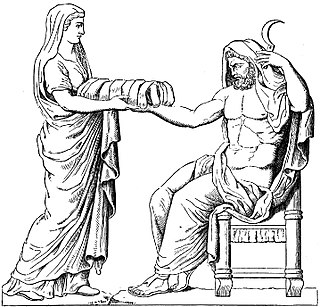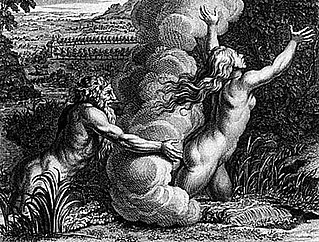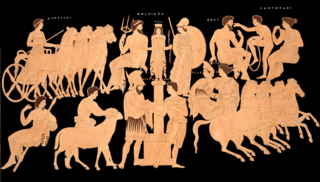In Ancient Greece, the dynasty of Iamidai (Latinised as Iamidae) at Olympia were an extended family of seers, the "house of Iamos", [1] one of the two clans from which the administrators of the Olympic Games were drawn, well into the 3rd century CE. At Olympia, they would interpret the entrails of burnt offerings. Like their equals at Olympia, [2] the Klytidai, who claimed descent from Melampous, by way of Klytios, grandson of Amphiaraos, the Iamidai claimed descent from Iamos, a son of Apollo [3] (the central figure of the west pediment) [4] and was the mythical ancestor of the Iamidai. Tisamenos was induced to leave Elis and advise Sparta, in return for which he and his heirs were accorded citizenship, the only outsiders ever to have been honoured in this way; Pausanias noted at Sparta in the 2nd century BCE ""a tomb to the soothsayers from Elis, the so-called Iamidai". [5]

Ancient Greece was a civilization belonging to a period of Greek history from the Greek Dark Ages of the 12th–9th centuries BC to the end of antiquity. Immediately following this period was the beginning of the Early Middle Ages and the Byzantine era. Roughly three centuries after the Late Bronze Age collapse of Mycenaean Greece, Greek urban poleis began to form in the 8th century BC, ushering in the Archaic period and colonization of the Mediterranean Basin. This was followed by the period of Classical Greece, an era that began with the Greco-Persian Wars, lasting from the 5th to 4th centuries BC. Due to the conquests by Alexander the Great of Macedon, Hellenistic civilization flourished from Central Asia to the western end of the Mediterranean Sea. The Hellenistic period came to an end with the conquests and annexations of the eastern Mediterranean world by the Roman Republic, which established the Roman province of Macedonia in Roman Greece, and later the province of Achaea during the Roman Empire.

Olympia, is a small town in Elis on the Peloponnese peninsula in Greece, famous for the nearby archaeological site of the same name, which was a major Panhellenic religious sanctuary of ancient Greece, where the ancient Olympic Games were held. The site was primarily dedicated to Zeus and drew visitors from all over the Greek world as one of a group of such "Panhellenic" centres which helped to build the identity of the ancient Greeks as a nation. Despite the name, it is nowhere near Mount Olympus in northern Greece, where the Twelve Olympians, the major deities of Ancient Greek religion, were believed to live.

The ancient Olympic Games were originally a festival, or celebration of and for Zeus; later, events such as a footrace, a javelin contest, and wrestling matches were added. The Olympic Games were a series of athletic competitions among representatives of city-states and one of the Panhellenic Games of ancient Greece. They were held in honor of Zeus, and the Greeks gave them a mythological origin. The first Olympics is traditionally dated to 776 BC. They continued to be celebrated when Greece came under Roman rule, until the emperor Theodosius I suppressed them in AD 393 as part of the campaign to impose Christianity as the State religion of Rome. The games were held every four years, or olympiad, which became a unit of time in historical chronologies.

Rhea is a character in Greek mythology, the Titaness daughter of the earth goddess Gaia and the sky god Uranus as well as sister and wife to Cronus. In early traditions, she is known as "the mother of gods" and therefore is strongly associated with Gaia and Cybele, who have similar functions. The classical Greeks saw her as the mother of the Olympian gods and goddesses, but not as an Olympian goddess in her own right. The Romans identified her with Magna Mater, and the Goddess Ops.

Alpheus or Alpheios, was in Greek mythology a river and river god.

In Greek mythology, Pelops, was king of Pisa in the Peloponnesus. His father, Tantalus, was the founder of the House of Atreus through Pelops's son of that name.

Hippodamia was a Greek mythological figure. She was the queen of Pisa as the wife of Pelops.

In Greek mythology, King Oenomaus of Pisa, the father of Hippodamia and the son of Ares. His name Oinomaos signifies him as a wine man.
In Classical Greek mythology, Taygete was a nymph, one of the Pleiades according to the Bibliotheca (3.10.1) and a companion of Artemis, in her archaic role as potnia theron, "Mistress of the animals", with its likely roots in prehistory. Mount Taygetos in Laconia, dedicated to the goddess, was her haunt.
Tisamenus, in Greek mythology, was a son of Orestes and Hermione, daughter of Menelaus, or Erigone, daughter of Aegisthus who were first cousins twice over, so Tisamenus had only five great-grandparents, instead of the usual eight. Tisamenus succeeded his father to the thrones of Argos, Mycenae and Sparta.

Pausanias was a Greek traveler and geographer of the second-century AD, who lived in the time of Roman emperors Hadrian, Antoninus Pius, and Marcus Aurelius. He is famous for his Description of Greece, a lengthy work that describes ancient Greece from his first-hand observations. This work provides crucial information for making links between classical literature and modern archaeology. Andrew Stewart assesses him as:
A careful, pedestrian writer...interested not only in the grandiose or the exquisite but in unusual sights and obscure ritual. He is occasionally careless or makes unwarranted inferences, and his guides or even his own notes sometimes mislead him, yet his honesty is unquestionable, and his value without par.

Cynisca or Kyniska was a Greek princess of Sparta. In 396 BC, she became the first woman in history to win at the ancient Olympic Games.

Nemea is an ancient site in the northeastern part of the Peloponnese, in Greece. Formerly part of the territory of Cleonae in ancient Argolis, it is today situated in the regional unit of Corinthia. The small village of Archaia Nemea is immediately southwest of the archaeological site, while the new town of Nemea lies to the west.

Amykles is a village in Laconia, southern Greece. It lies in the plain by the Eurotas river, 6 km south of Sparta, east of the Taygetus mountains, along the Greek National Road 39 from Sparta to Gytheio. It was named after the ancient town Amyclae, the ruins of which are situated 2 km northeast of the village.

The Temple of Zeus at Olympia was an ancient Greek temple in Olympia, Greece, dedicated to the god Zeus. The temple, built in the second quarter of the fifth century BCE, was the very model of the fully developed classical Greek temple of the Doric order.
Pisa was a town in Peloponnesus, that was in the most ancient times the capital of an independent district, called Pisatis, which included Olympia, the site of the Ancient Olympic Games, and Dyspontium. The Pisatis subsequently formed part of the territory of ancient Elis.

The Sanctuary of Artemis Orthia, an Archaic site devoted in Classical times to Artemis, was one of the most important religious sites in the Greek city-state of Sparta, and continued to be used into the fourth century CE.
The Bacchiadae, a tightly-knit Doric clan, were the ruling family of archaic Corinth in the eighth and seventh centuries BCE, a period of Corinthian cultural power.
Aetolus was, in Greek mythology, a son of Endymion, great-great-grandson of Deucalion, and a Naiad nymph (Neis), or Iphianassa.

In Greek mythology, Gaia, also spelled Gaea, is the personification of the Earth and one of the Greek primordial deities. Gaia is the ancestral mother of all life: the primal Mother Earth goddess. She is the immediate parent of Uranus, from whose sexual union she bore the Titans and the Giants, and of Pontus, from whose union she bore the primordial sea gods. Her equivalent in the Roman pantheon was Terra.
Lacedaemon was a mythical king of Laconia and son of the Pleaid Taygete and Zeus in Classical Greek mythology. He was a father of King Amyclas of Sparta and Queen Eurydice of Argos, with Princess Sparta, the daughter of King Eurotas. Taygete has an association with Artemis in earlier mythology.
In ancient Greek religion and mythology, Melia, a daughter of the Titan Oceanus, was the consort of Apollo, and the mother, by Apollo, of the Theban hero and prophet Tenerus. She was also the mother of Ismenus, god of the Theban river of the same name. Melia was an important cult figure at Thebes. She was worshipped at the Ismenion, the Temple of Apollo at Thebes, and was associated with a nearby spring.














